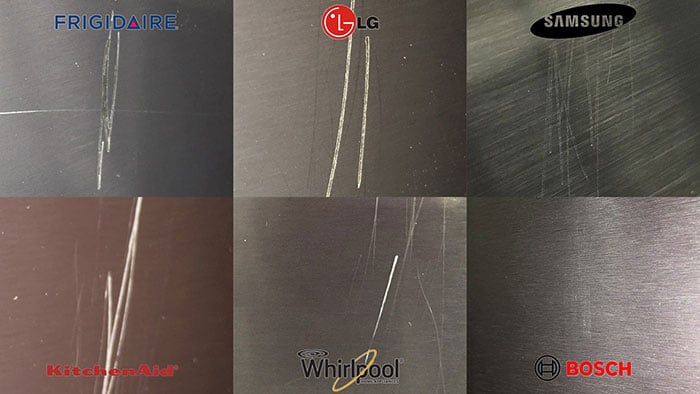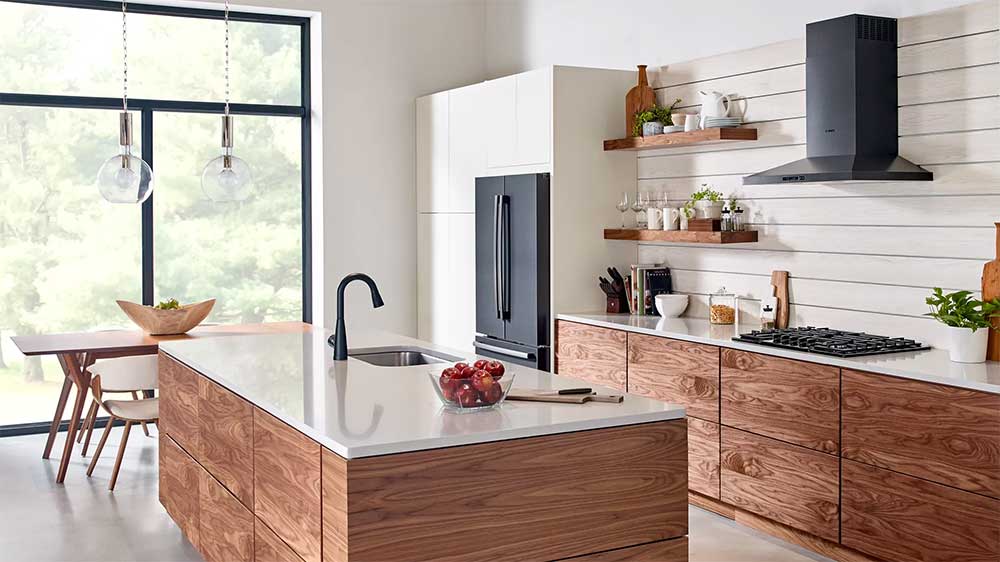Black stainless steel once accounted for 20–30 percent of kitchen appliance sales in the United States, positioned as a stylish alternative to traditional stainless steel.
It was the first real challenge to stainless steel's dominance since the 1990s.
When I originally wrote about black stainless steel in 2016, it was the hot new finish. But now?
Fewer than 1 percent of kitchen packages sold include it, and that number is still dropping.
It serves as a cautionary tale, similar to other highly publicized but untested new appliances.
You probably already suspect that black stainless isn't a great choice.
This article will confirm that and offer better alternatives.
📌Skip Ahead:
Quick Answer: Is Black Stainless Worth It?
Short answer: No.
If you absolutely must, Bosch offers the most scratch-resistant version because they bake the color into the metal rather than applying a surface finish.

However, if black stainless gets discontinued across all brands, expect prices to drop dramatically.
At that point, you might consider it, but only if you can keep kids and guests from touching it.
My Parents' Experience with Black Stainless-Steel Appliances

My folks retired down South.
I visit them often, and I feel like they love seeing me mainly because they get to see my eight-year-old daughter.
Anyway, I walked into their home, and in their garage sat a Samsung black stainless refrigerator.

Let's just say they aren’t avid readers of the Yale Home Appliance Blog.
In their defense, the price was shockingly low, and since it was in their garage, they didn’t care about the finish issues.
We stopped selling black stainless shortly after problems started appearing.
But during the pandemic, we did sell Samsung black stainless French-door refrigerators for $799 because people just needed freezers.
Still, you shouldn't buy black stainless steel for your kitchen.
If aesthetics don't matter, say in a garage or pantry, it might be a bargain buy.
Editor's Note: Black stainless could be a smart choice in secondary spaces because it’s often significantly cheaper than standard stainless steel.
If you’re flipping a house, buying black stainless at a discount might make sense, unless your buyers check online reviews first.
What Is Black Stainless Steel, Really?

Black stainless steel is marketed as a sleek, modern alternative to stainless steel, offering a darker hue that coordinates well with most cabinet styles.
It looks good. It's also easier to clean than stainless steel.
But here’s the problem: black stainless is just a coating—like a veneer—applied to regular stainless steel.
For most brands, it’s not a baked-on or painted finish. Bosch is the exception.
That "veneer" scratches easily, exposing the shiny metal underneath.
Why Is Black Stainless Steel Declining in Popularity?
Black stainless steel was once a popular choice for homeowners looking for something different. In 2018, black stainless appliances accounted for about 25 to 30 percent of kitchen package sales in the U.S.
But at Yale, we stopped selling it entirely after 2021.
The reason?
It scratches easily, and repairing it is nearly impossible.
When the finish scratches, it reveals bright stainless beneath, making the damage highly visible, like a constellation of tiny stars across your fridge.

If you have small children or use your appliances often, you’ll quickly regret the purchase.
🔍Read More: Does Black Stainless Steel Scratch Easily?
The Problems with Black Stainless-Steel Appliances
1. Black Stainless Steel Is Likely Being Discontinued

If black stainless is discontinued, you’ll have to replace individual appliances with standard stainless steel over time, leading to a mismatched kitchen.
As of 2025, black stainless appears to be on the chopping block.
Samsung, the trendsetter in appliance finishes, has already pivoted to Matte Black, a baked-in finish.
They probably don’t need two shades of black. Plus, Samsung was sued in Texas over black stainless peeling off appliances, so that might help speed up its demise.
Meanwhile, major brands like Café, Profile, BlueStar, Fisher & Paykel, and LG are investing in true black finishes instead of black stainless. Even Wolf now offers a black option.
2. Scratches Are Not Repairable
There’s no good way to fix black stainless once it scratches.
Your only option might be to peel off the coating entirely and revert to a stainless-steel kitchen.
Also, black stainless finishes vary between brands, so you can’t mix and match different manufacturers without creating a mismatched look.
What Are the Best Alternatives to Black Stainless Steel?
If you’re looking for a unique finish, you have better options:
Classic Stainless Steel
.jpg?width=1200&height=675&name=Cafe-Appliances-in-Stainless-Steel%20(1).jpg)
The safe and timeless choice. If you want a change, consider brushed or smudge-resistant stainless finishes.
White Appliances

White was the high-end finish before stainless took over in the ’90s. Now, it’s making a comeback.
- Café Appliances offers white finishes with six different handle options (black, copper, brass, etc.).
- Samsung and KitchenAid offer white with stainless handles—very similar to the old Frigidaire Gallery look.
- Fisher & Paykel has a modern, bright white finish that feels high-tech.
Matte and Gloss Black

Black appliances (not black stainless) are becoming increasingly popular.
- Café Appliances: Matte black with customizable handle options.
- BlueStar: Beautiful matte black finishes.
- Fisher & Paykel: A contemporary gloss black option.
- Wolf: Finally offering black after years of resisting color.
Custom Color Finishes

If you want something bold, a few brands offer fully customizable color finishes:
- BlueStar: Over 1,000 color and trim combinations.
- True Refrigeration: Racing-inspired colors with six hinge accents.
- La Cornue: The gold standard in luxury color finishes, with 50+ options.
- Viking: Partnered with Benjamin Moore to relaunch 17 designer colors.
Not sure which finish is right for you? Here’s how black stainless stacks up against other popular choices:
| |
Pros |
Cons |
Best Brands |
| Black Stainless |
Sleek, darker alternative to stainless, easier to clean (at first) |
Scratches easily, damage is permanent, finishes vary by brand, likely to be discontinued |
Bosch (most durable), Samsung (widespread), LG |
| Stainless |
Durable, timeless, easy to match, widely available |
Shows fingerprints and smudges (unless smudge-resistant) |
Sub-Zero, Bosch, Miele, Thermador, Wolf |
| White |
Bright, clean, modern options with customizable handles |
May look dated depending on design; limited availability |
Café (custom handles), Samsung, KitchenAid, Fisher & Paykel |
| Matte Black |
Modern and elegant; hides fingerprints better than glossy finishes |
Fewer models available compared to stainless |
Café, BlueStar, Fisher & Paykel, Wolf |
| Gloss Black |
Bold and dramatic; high contrast with lighter cabinetry |
Shows smudges and dust easily; limited selection |
BlueStar, Wolf |
| Custom Color Finishes |
Unique and expressive; thousands of color and trim combinations available |
Expensive; long lead times; harder to match across all kitchen appliances |
BlueStar (1,000+ colors), True, La Cornue, Viking |
| Cabinet Panel-Ready |
Seamless, built-in look that blends into cabinetry; high-end aesthetic |
More expensive installation; fewer compatible appliances |
Sub-Zero, Miele, Bosch, Thermador |
🔍Read More: Best Stainless Steel Alternatives for Kitchen Appliances
Key Takeaways
Before buying black stainless (or any designer finish), research your options carefully.
Black stainless steel scratches easily, revealing bright stainless beneath.
Repairs are impossible, and once discontinued, you'll be stuck replacing individual pieces with standard stainless.
Consider better alternatives like classic stainless, true black, white, or even fully custom colors.
If you're flipping a house, black stainless may be worth considering if the price is significantly discounted.
If you’re designing a long-term kitchen, black stainless steel is not a smart investment.
Choose a finish that will stand the test of time—both in durability and style.
Additional Resources
Every homeowner has the same fear: “What if I buy the wrong appliance?”
You don’t need another slick sales pitch—you need real data. That’s why we created the Appliance Buying Guide, packed with:
✔️Reliability stats from 33,000+ service calls
✔️Brand comparisons based on real-world performance
✔️Answers to the 10 biggest appliance-buying questions
Make a decision with confidence. Get the guide now. It’s free.
Related Articles










.jpg?width=1200&height=675&name=Cafe-Appliances-in-Stainless-Steel%20(1).jpg)


